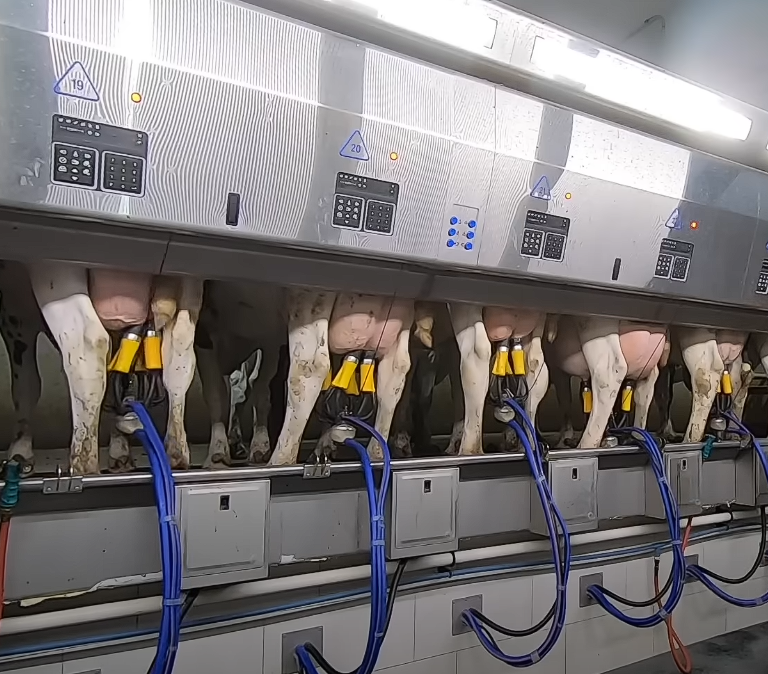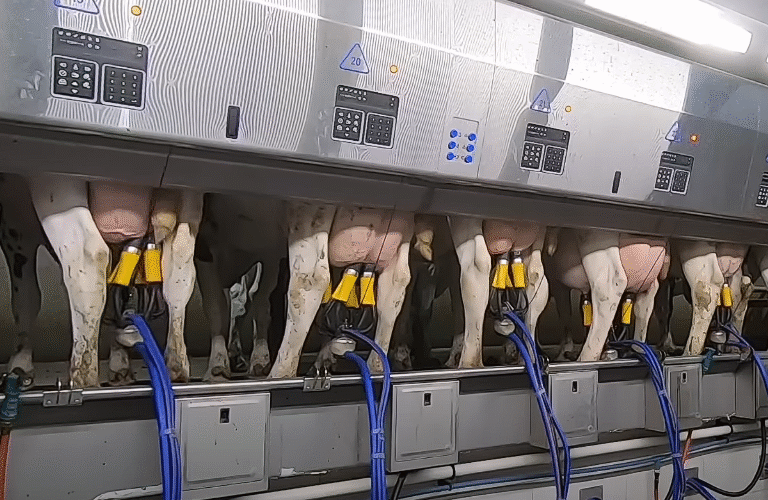From Pasture to Parlor: The Journey of Milk
Milk is one of the most consumed beverages around the world, but few people truly understand the process that brings it from the cow to your table. Today’s dairy industry is a fascinating blend of tradition and technology — and the milking process has evolved significantly over the decades.
The image above offers a glimpse into a modern milking parlor. Dozens of cows stand side by side, each connected to automated milking machines. Their udders are gently suctioned by machines designed to extract milk efficiently and hygienically. This isn’t the small family farm of the past — it’s high-tech agriculture at work.
The Evolution of Cow Milking
For centuries, milking cows was a manual task. Farmers would sit on stools and use their hands to extract milk from each teat, one cow at a time. It was slow, labor-intensive, and inconsistent. As dairy demand grew, so did the need for efficiency.
In the early 20th century, the first mechanical milking machines were introduced. These machines mimicked the suction of a calf’s mouth using a vacuum pump. Over the years, the technology improved dramatically. Today’s milking parlors use computer-controlled systems that monitor milk flow, detect abnormalities, and even track each cow’s health and productivity.
How a Modern Milking Parlor Works
Walking into a modern milking parlor, you’re greeted by an orchestra of machinery and movement. Cows are herded into stalls and positioned so their udders face the milking equipment. Before milking begins, each udder is cleaned and sanitized to ensure the highest hygiene standards.
Then, the milking machines are attached. Each unit has four suction cups — one for each teat — connected to a system of hoses and sensors. These machines extract milk gently but efficiently, often completing a cow’s milking session in just 5 to 8 minutes.
Sensors measure the milk volume and can detect changes in milk quality. If a cow’s milk shows signs of illness or contamination, the system automatically diverts it from the main storage tank. This ensures only safe, high-quality milk continues down the pipeline.
The Importance of Cow Comfort
Contrary to common misconceptions, cows in modern dairy farms are not mistreated. In fact, their health and comfort are top priorities for farmers. A stressed or unhealthy cow produces less milk, so dairy farmers invest heavily in cow welfare.
In milking parlors, cows stand on cushioned floors. Ventilation systems keep the air fresh and cool. Some farms even play calming music during milking sessions to help cows relax. Regular veterinary checkups, proper nutrition, and plenty of clean water are also essential.
Milk Storage and Processing
Once the milk leaves the cow, it travels through a closed piping system to large refrigerated storage tanks. These tanks chill the milk to around 4°C (39°F) to prevent bacterial growth. From there, it is transported in insulated tankers to processing facilities.
At the plant, the milk is pasteurized (heated to kill harmful bacteria), homogenized (so the cream doesn’t separate), and tested for quality and safety before packaging. Within 24 to 48 hours, milk can go from the farm to grocery store shelves — a testament to the efficiency of modern dairy systems.
Benefits of Automation
Automating the milking process offers several key benefits:
- Consistency: Machines apply uniform pressure and rhythm, ensuring a smooth milking process.
- Hygiene: Reduced human contact lowers the risk of contamination.
- Efficiency: One person can manage dozens of cows, improving labor productivity.
- Data Tracking: Farmers can monitor milk output, udder health, and cow behavior in real-time using digital dashboards.
This data-driven approach allows early detection of illnesses, optimizing cow care and reducing the use of antibiotics.
Challenges in the Dairy Industry
Despite the technology and advancements, the dairy industry faces numerous challenges:
- Animal welfare concerns from the public require transparency and ethical practices.
- Fluctuating milk prices can make it hard for small farms to stay profitable.
- Environmental impact from manure, water usage, and greenhouse gases needs continual improvement.
- Labor shortages make it difficult to find workers willing to manage farms, even with automation.
To address these, many farms are turning to sustainability efforts such as recycling water, using manure for energy (biogas), and implementing better waste management systems.
The Future of Dairy Farming
Looking ahead, the future of cow milking may involve even more advanced technologies like robotic milking arms, wearable health monitors for cows, and AI-driven analytics to improve herd health and production.

Some farms already use rotary milking systems where cows walk onto a rotating platform and are milked as the platform moves. Others are exploring fully autonomous robotic parlors where cows choose when to be milked — a stress-free, cow-led process that’s gaining popularity.
Final Thoughts
Milking cows is no longer just about buckets and barns. It’s a complex, high-tech operation that blends agricultural tradition with cutting-edge innovation. As consumers, understanding where our food comes from helps us appreciate the effort, care, and science behind every glass of milk.
Modern dairy farmers are stewards of both their animals and the land. Through their dedication and constant evolution, the simple act of milking has become a marvel of modern agriculture.
